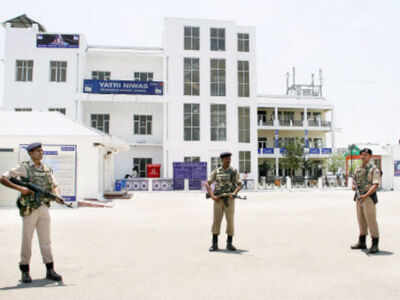- News
- India News
- Authorities conduct mock exercises for Amarnath Yatra
Trending
This story is from June 28, 2016
Authorities conduct mock exercises for Amarnath Yatra

(PTI photo)
NEW DELHI: The National Disaster Management Authority (NDMA) conducted mock exercises at Baltal and Pahalgam base camps in Jammu & Kashmir to assess the preparedness of all the stakeholders involved in the management of the upcoming Amarnath Yatra.
The mock exercises were conducted from June 23 to June 28.
The annual Amarnath Yatra to the cave shrine in south Kashmir will begin from July 2.
The first mock exercise was conducted along the route from Baltal in Ganderbal district from June 23 to June 25. The exercise dealt with simulated scenarios involving a cloudburst and a fire.
Two batches of NDMA experts, led by Major General VK Datta (Retd) and BB Gadnayak, trained the participants on key aspects of disaster management such as the formation of Incident Response Teams, coordination among various participating agencies, evacuation, medical preparedness and trauma counselling.
The exercise aimed at enhancing the preparedness of officials of the Amarnath Shrine Board (SASB), district administration and other key government agencies to deal with any disaster during the Yatra, said Maj Gen VK Datta.
Both the mock exercises began with a coordination conference followed by a table-top exercise.
Senior officials from all the important departments such as the Amarnathji Shrine Board (SASB), National Disaster Response Force (NDRF), State Disaster Response Force (SDRF), Rashtriya Rifles, Central Reserve Police Force (CRPF), army, police, health, civil defence, transport, fire and other emergency services attended these preparatory meetings and participated in the mock exercises.
After the drills, post-exercise analysis was carried out by NDMA experts in which they discussed the entire operation and underlined areas that needed improvement. “Better coordination among various agencies is of utmost importance and often the key to a successful post-disaster response,” said Gadnayak.
The mock exercises were conducted from June 23 to June 28.
The annual Amarnath Yatra to the cave shrine in south Kashmir will begin from July 2.
The first mock exercise was conducted along the route from Baltal in Ganderbal district from June 23 to June 25. The exercise dealt with simulated scenarios involving a cloudburst and a fire.
The second mock exercise was conducted along the camp sites on the Chandanwari route from June 26 to June 28, and covered both natural as well as man-made disasters.
Two batches of NDMA experts, led by Major General VK Datta (Retd) and BB Gadnayak, trained the participants on key aspects of disaster management such as the formation of Incident Response Teams, coordination among various participating agencies, evacuation, medical preparedness and trauma counselling.
The exercise aimed at enhancing the preparedness of officials of the Amarnath Shrine Board (SASB), district administration and other key government agencies to deal with any disaster during the Yatra, said Maj Gen VK Datta.
Both the mock exercises began with a coordination conference followed by a table-top exercise.
Senior officials from all the important departments such as the Amarnathji Shrine Board (SASB), National Disaster Response Force (NDRF), State Disaster Response Force (SDRF), Rashtriya Rifles, Central Reserve Police Force (CRPF), army, police, health, civil defence, transport, fire and other emergency services attended these preparatory meetings and participated in the mock exercises.
After the drills, post-exercise analysis was carried out by NDMA experts in which they discussed the entire operation and underlined areas that needed improvement. “Better coordination among various agencies is of utmost importance and often the key to a successful post-disaster response,” said Gadnayak.
End of Article
FOLLOW US ON SOCIAL MEDIA










